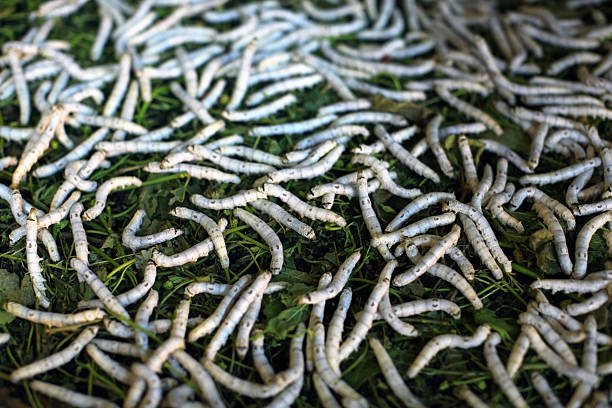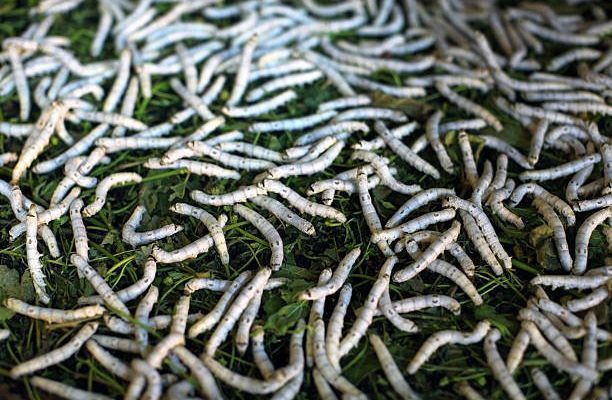
Silkworms are fascinating little insects. They may be small, but they play a gigantic role in the world of textiles. Imagine these little guys munching on mulberry leaves, transforming their diet into soft, beautiful silk. Different silkworm breeds yield different amounts of silk, making it essential to understand which ones are the most productive. This knowledge can help farmers, weavers, and even fashion designers optimize their processes and find the best silkworms for their needs.
Let’s dive into the world of silkworms and explore how silk yield varies across different breeds. By the end, you’ll have a better grasp of why this topic matters and how it impacts everything from the cost of your favorite silk scarf to the sustainability of silk production.
What is Silk Yield?
Silk yield refers to the amount of silk produced by a silkworm during its life cycle. Picture a factory making your favorite snacks. The efficiency of each machine determines how many snacks come out at the end. In the same way, the silk yield of each silkworm breed affects how much silk can be harvested.
Generally, silk yield is measured in terms of weight, usually expressed in grams. The yield can vary significantly based on the breed, the environment in which they’re raised, and the care they receive. For example, a well-cared-for silkworm may produce more silk than one raised in poor conditions.
Moreover, **factors influencing silk yield** include:
- The breed of the silkworm
- The quality of the mulberry leaves they eat
- The conditions of their environment, such as temperature and humidity
Understanding silk yield provides valuable insights for sericulture (the practice of raising silkworms), allowing farmers to select the best breeds for higher production.
Types of Silkworm Breeds
There are several breeds of silkworms, each with unique characteristics and silk production capacities. The most common breeds include the **Bombyx mori**, **Bombyx mandarina**, and **Bombyx mori hybrids**.
**Bombyx mori** is the most famous silkworm breed. It’s often raised in large quantities for commercial silk production. This breed can yield between 20 to 50 grams of silk per larva! That’s pretty impressive for such a small creature.
On the other hand, **Bombyx mandarina** is less known but is often found in the wild. It can produce silk, but not as much as its domesticated cousin. While it may have its unique charm, it’s not as efficient for large-scale silk production.
Then we have the hybrids, which are created by crossbreeding different silkworm breeds. Hybrids can be engineered for improved yields, combining desirable traits from various silkworms. They often bring higher silk yield potential, making them a favorite among sericulture practitioners.
Factors Affecting Silk Yield in Silkworms
When it comes to raising silkworms, several factors can impact their silk yield. **Nutrition** is a key player. Silkworms primarily feed on *mulberry leaves*, and if these leaves lack nutrients, the silkworms will not produce quality silk. A balanced diet is essential.
**Climate and environment** also play crucial roles. Silkworms thrive in warm, humid conditions. If the environment is too dry or cold, it can affect their growth and silk production. For instance, if temperatures drop dramatically, silkworms may enter a dormant state, halting silk production entirely.
Finally, **care and management practices** significantly influence silk yield. Proper hygiene, disease control, and monitoring growth stages can help silkworms reach their full potential. Think of it like tending to a garden. If you nurture your plants with water, sunlight, and care, they’ll flourish—and so will the silkworms!
Comparing Silk Yields Across Breeds
Now that we have a grasp of what impacts silk yield, let’s compare the actual numbers. Here’s a quick overview of some popular breeds and their average silk yields:
| Silkworm Breed | Average Silk Yield (grams per larva) |
|---|---|
| Bombyx mori | 20-50 |
| Bombyx mandarina | 10-15 |
| Hybrid breeds | 25-60 |
As you can see, the **Bombyx mori** takes the lead for commercial production, while hybrids are making waves with their potential higher yields. This comparison is vital for anyone in the silk industry because it helps guide decisions on which breeds to raise based on desired production levels.
Silk Quality vs. Silk Yield
While silk yield is important, we can’t forget about silk quality. Think about it—would you rather have a lot of low-quality silk or a smaller amount of high-quality silk? Honestly, most consumers would choose quality over quantity.
Silk quality is influenced by the thickness and smoothness of the silk threads, which can vary from breed to breed. The **Bombyx mori** tends to produce the highest quality silk, renowned for its shine and softness. On the flip side, while breeds like **Bombyx mandarina** may yield less silk, their product can sometimes have a unique feel and texture that some artisans love to work with.
Imagine a beautiful silk scarf. The quality of the silk impacts not just its look and feel but also its price. So, there’s a delicate balance between striving for higher yields and maintaining that luxurious silk quality.
The Future of Silkworm Breeds and Silk Production
As we look ahead, the future of silkworm breeds and their silk yield potential is promising. With advancements in breeding techniques and better understanding of their biology, we can expect improvements in both yield and quality.
Research is actively exploring ways to enhance the nutritional value of mulberry leaves and optimize breeding practices. This innovation means potentially higher silk yields and better quality silk, making it a win-win for producers and consumers alike.
Moreover, as sustainability becomes increasingly important, there’s a push to develop silkworm breeds that require fewer resources and can thrive in various environments. This could change the game for silk production, making it more accessible and eco-friendly for everyone involved.
Understanding silk yield per silkworm breed brings us one step closer to appreciating the beauty and complexity of silk production. From the *Bombyx mori* leading the charge in commercial yields to the fascinating world of hybrids and their potential, the topic is rich and rewarding.
As you navigate the world of silk, remember that each thread has a story—a story rooted in the silkworms that worked hard to produce it. Whether you’re a farmer, designer, or simply a silk lover, knowing about these breeds and their yields can deepen your connection to this luxurious fabric. Next time you wrap yourself in that silk scarf, think of those tiny silkworms. They’ve done an incredible job, and now you know just how much effort it took to bring that silk into your life!

